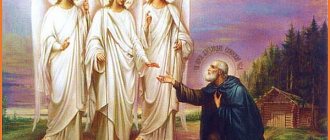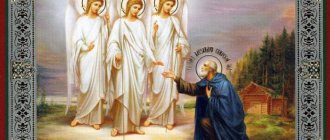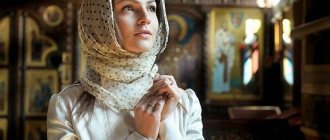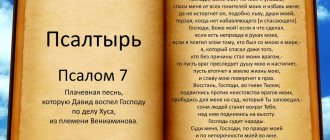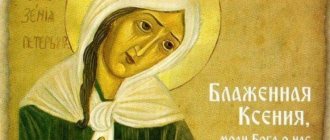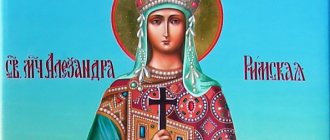The future saint was born into a family of simple peasants in the middle of the 16th century. The parents of Alexander Svirsky were childless for a long time and asked God for an heir, so they named their long-awaited son Amos, in honor of one of the biblical prophets. From childhood, Amos showed an interest in prayer and the study of theology. At the age of twelve, the young man declared that he wanted to devote his life to serving God and take monastic vows. This news greatly upset his parents: their only son deprived them of the happiness of babysitting their grandchildren. And so, at the age of twelve, in defiance of his elderly father and mother, Amos took monastic vows, receiving the Orthodox name Alexander, and secretly went to Valaam. The young man did not know the way to the city, he simply wandered away from his father’s house. But the angels who appeared to him showed young Amos the way.
He spent seven years in humble service to God. After this time, the face of the Trinity appeared to the saint. Before this, only Abraham had seen God in all three of his faces. Alexander's conversation with God was about how to gather the brethren and about the construction of the temple. The saint devoted many years to the construction and decoration of the temple, erected in the place that the Trinity showed him. We are talking about the Trinity Monastery, the most beautiful cathedral in Rus'. Enormous funds and efforts were allocated for the construction of this temple; many people: from trained builders to clergy and ordinary believers - worked on the construction of the temple and brought donations.
Brief biography of the saint
The wonderworker Alexander Svirsky was born on June 15, 1448 and was named Amos - in honor of the Old Testament prophet. His parents were deeply religious peasants from the village of Mandera in the Novgorod region. Their names were Stefan and Vassa. For many years the couple could not have children, and only after praying to God asking for help did they find an heir at an advanced age.
Even in early childhood, the future prophet was distinguished by his special spirituality, piety and kindness. His parents tried to give him a good education for those times, sending him to school to study literacy. At a young age, they tried to arrange Amos’s personal life, seeing in him a continuation of the family line. But the heart and soul of the saint, from childhood, completely belonged to the Lord.
Depiction of the vision of the Holy Trinity
Having reached adulthood, Amos secretly left home and, together with monks passing by the village, went to Valaam. After seven years of hard work, he took monastic vows and took a new name - Alexander. At that time, the future miracle worker was 26 years old. It was then that the parents learned about their son’s whereabouts and came to meet him. After a long conversation, Alexander was able to console and encourage them, and convey to them the Word of God. After meeting their son, Stefan and Vassa took monastic vows in the northern monastery and became Sergius and Varvara.
The prophet spent another 7 years on Valaam, building a cell in a rock crevice. Nowadays, you can see there a beautiful monastery in the name of St. Alexander of Svirsky with a majestic white-stone church.
Upon returning to his native land, the saint built a cell and began to lead a solitary ascetic lifestyle. He brought with him not only faith in the Lord, but also much new knowledge. The monk provided enormous assistance in treating people, raising seemingly incurable patients to their feet. Monks began to visit the cell more and more often, and over time a monastery grew around Alexander’s refuge. In 1508, the saint accepted the priesthood and the rank of hegumen there, calling the monastery the Church of the Transfiguration of the Lord.
Members of the royal family often visited her, and even Ivan the Terrible visited the monk and asked him for advice. Soon after this, the Church of the Life-Giving Trinity was built. Shortly before his death, Alexander Svirsky completed the construction of the Intercession Church, for which he was blessed by the Mother of God herself. The elder died at the age of eighty-six in 1533, and 14 years later he was canonized and named venerable.
Basic facts of the saint's biography
The founder of the Holy Trinity Monastery has a truly amazing biography. During his lifetime, Alexander Svirsky became famous as a sorcerer. He is considered the second person in history to see the Holy Trinity after Abraham, the righteous man of the Old Testament.
Since childhood, the future monk dreamed of devoting his entire life to worship. His life path is full of truly good deeds, thanks to which this saint has been revered by Orthodox Christians for almost half a millennium. Let us dwell in detail on each of the significant stages of the biography of the monk Alexander of Svirsky.
Childhood and origins
The future saint was born in 1448 in the village of Mandera, Novgorod region. His parents were farmers. They already had two adult sons, and they asked the Lord to send them another son. The parents named their third child Amos in honor of the biblical prophet. He was given a Christian upbringing so that the child would grow up obedient and kind.
Despite the fact that at first the boy lagged behind his peers in his studies, he later caught up with them and even achieved some success in studying natural science.
Amos began going to church early, which subsequently influenced his life path, thanks to which the boy decided to devote his future life to church service.
Road to the monastery
In his youth, Amos had already firmly decided that he wanted to become a monk, despite the fact that his relatives wanted a quiet family life for the young man. The boy communicated a lot with the elders of Valaam and at the age of nineteen, inspired by their stories from monastic life, he secretly left for Valaam from his parents. Tradition says that the Lord sent a guardian angel to Amos, who knew the way to the temple and became the young man’s companion.
Amos lived for seven years as a novice in the North Athos Monastery. The father, having learned where his son was, himself arrived at the monastery and persuaded his son to return. However, the young man firmly decided to devote himself to monasticism, so he invited his parents to take monastic vows.
Serving God after tonsure
Amos took monastic vows, taking the name Alexander. His parents, like their son, took monastic vows. Alexander settled on an island in Lake Ladoga. Life says that the monk had healing abilities, and their fame spread throughout the surrounding area. People began to come to him to treat their ailments.
Foundation of a new monastery
After Alexander left the monastery and began to live on the shore of the lake, building himself a hut. Here the monk lived for seven full years, eating only the gifts of the forest. Alexander suffered from illness and hunger, but the Lord gave him the strength to endure physical torment. Even when the saint was almost paralyzed and could not move, he read the psalms while lying down. Later, on the site of the wooden house in which the monk lived, the Alexander-Svirsky Monastery will be founded.
The monk’s first student was Andrei Zavalishin, who came across a hut while hunting. He, following the example of the saint, took monastic vows and subsequently became famous for his good deeds. Gradually, rumors about Alexander spread throughout the surrounding area, and more and more students began to come to him. The monk guided people on the path of faith, after which many of his students founded their own Orthodox communities.
Appearance of the Holy Trinity
One day, during night prayer, the Holy Trinity appeared to the saint’s gaze. The monk saw three men in white robes. They held their wands in their hands, and they sparkled with heavenly radiance. Alexander bowed in fear, but the people told him not to be afraid. They ordered the saint to build a temple in the name of the Trinity. After which the monk saw the Lord himself. In the history of Russian Orthodoxy, this moment became known as the only divine indulgence.
From that moment on, the monk began to think about where to build a temple. And one day, during another prayer, an angel came to him and ordered him to begin building a church on this very spot.
Receiving the priestly rank
After the appearance of the Trinity, the monk began construction of the church. Under his leadership, a wooden church was erected, and a few years later - a stone one. The Monk Alexander Svirsky accepted the abbess and received the rank of priest. The saint himself worked during construction along with everyone else, and he himself went to chop wood when there was not enough of it.
Foundation of the Intercession Church
Before his death, the monk decided to build a stone church of the Intercession of the Most Holy Theotokos. After the foundation of the temple was laid, the spirit of the Most Holy Theotokos appeared to Alexander in his cell with the Child. Jesus is in my hands. He was illuminated by the light of many angels. The saint fell to his knees, unable to resist the bright light.
The Mother of God told him that for his prayers for the disciples, the built church would abound for many years after his death, giving everything the disciples needed. The saint stood up, and before his eyes appeared countless people suffering to become his disciples.
Death and canonization
Before leaving for another world, Alexander ordered his brothers to tie up his corpse and bury it in swamp moss. The brothers refused to bury the monk in this way, so he ordered him to be buried in the desert near the church.
The Monk Alexander of Svirsky died at the age of eighty-five. Praised for his good deeds, he was canonized and canonized soon after his death, during the reign of Ivan IV.
Orthodox holidays are considered to be the day of presentation and the day of opening of the relics of the saint discovered during the reconstruction of the temple - August 30 and April 17, respectively. The altar wall in the temple radiates warmth even during frosts - this is considered a manifestation of the condescension of the Trinity.
History of the holy image
The first image of the Monk Alexander appeared in the 16th century, after his death. It was written by monks who knew the saint during his lifetime, so the similarity was almost one hundred percent. After this, lists of the same quality were distributed among monasteries and churches. Over the centuries, the image remained similar to the original due to the fact that the preserved relics of the holy elder miraculously did not suffer from time and remained in their original form. Icon painters always had the opportunity to compare their work with the true appearance of the monk.
In 1918, during the revolutionary events, both monasteries were looted, the monks were shot, and the remains of the saint were taken away. For a long time their fate was unknown, but in the 90s they were discovered at the Military Medical Academy of St. Petersburg. According to one legend, they were hidden by one of the employees of a certain museum. In 1998, the relics found their original location. There are also prayer icons in the Holy Trinity and Alexander-Svirsky churches in Moscow.
The first image of St. Alexander appeared in the 16th century
Where are the incorruptible relics located and stored?
Despite the fact that Alexander Svirsky was canonized fourteen years after his death, his relics were found and transferred to the monastery only a hundred years later. The novices, having opened the saint's coffin, found his body incorrupt. The relics were transferred to the Holy Trinity Monastery, and pilgrims began to come to them to venerate.
During Soviet times, the monastery was destroyed and the relics were confiscated. The monk's incorrupt body was hidden and discovered only in the late 1990s. The relics were returned to the monastery of the Holy Trinity Monastery, where they still rest.
Meaning and description of the divine image
The images of the saint are especially noteworthy for their almost photographic resemblance to the original image. Being far from the turbulent worldly life, Father Alexander created the moral foundations of our country, possessing the great gifts of the Lord. He received the title “Reverend,” which means “like God.” The Church willingly cooperates with scientists; many times the relics of St. Alexander of Svirsky were carefully studied by them using the latest technologies. However, the incomprehensible fact of the preservation of the remains of the saint in their original form for many centuries has not found scientific justification.
Iconography
The faces of St. Alexander are distinguished by a variety of types. One of the most revered images, now located in the Assumption Cathedral of the Kremlin, is a hagiographic icon dating back to the end of the 16th century, depicting him in monastic vestments. Unlike other hagiographic images, the number of marks here is 129.
The icon of Alexander Svirsky is one of the most revered in the Orthodox world
The face of the saint at the moment of the appearance of the Holy Trinity to Father Alexander, painted by the famous icon painter Saint Andrei Rublev, is unusual and unique. This image has become a symbol of divine power; it has truly miraculous power.
Days of Honor
Traditionally, there are two days on which Christians venerate Saint Alexander of Svirsky:
- April 30 (April 17, old style) - this day is associated with the discovery of sacred remains;
- September 12 (August 30, old style) is the day to honor the repose of the righteous.
However, on any day you can see many believers in churches who have come to worship the monk.
Location of the holy face
The relics of Alexander Svirsky are located in the Holy Trinity Monastery (Leningrad Region). In Russia, in almost every church you can see the image of this wonderworker, but the most revered icons are in Moscow, in the Church of the Life-Giving Trinity and in the Church of St. Alexander of Svir. There are lists of all significant icons on Valaam.
Holy Trinity Monastery
Church of the Life-Giving Trinity in Moscow
Church of St. Alexander Svirsky in Moscow
Evidence of the wonderworker's miracles
The monk's relics are considered one of the main miracles of Christianity. The Holy Monk Svirsky passed away almost five hundred years ago, but his body continues to remain in incredible integrity and safety during such a period of time. Scientists who have studied this phenomenon have testified that the body maintains a fresh appearance without the use of chemicals.
At the beginning of the 17th century, the Holy Trinity Monastery was attacked and destroyed several times. After the liberation of the lands, the monastery began to be restored. During the restoration of the stone Transfiguration Cathedral, relics were discovered in a deserted desert. While digging a ditch to build a wall, workers discovered the coffin of the deceased. The ground above the coffin was shaped like a cave, completely unsupported.
The body itself, to the surprise of the monks, retained its fresh appearance a hundred years after the death of the saint. On the night of viewing the relics, a divine light shone above them, illuminating the space.
Since then, many miracles have been witnessed from the dead. People who prayed to the relics received healing from ailments and relief from problems. There are several cases where married couples who could not have a child, after prayer and veneration of the relics, miraculously learned about the pregnancy of their spouses.
How does the icon of Alexander Svirsky help?
A huge number of believers annually make a pilgrimage to Valaam, asking for intercession and help. People come to church in difficult moments, offering prayers and petitions to Saint Alexander. The miracle worker helps those in need even after his death. They ask him for different things:
- seriously ill people, and sometimes suffering from incurable illnesses, people ask for healing of soul and body;
- those in doubt turn to gain or strengthen faith, to make the right decision, and ask for protection from unkind views and sinful thoughts;
- young parishioners ask their parents for their blessings for monastic life;
- those who are worried and confused pray for loved ones who have gone astray, to receive spiritual peace;
- Married couples who remain childless for a long time despite all attempts, turn to prayer for the gift of children.
Iconography
The very first icon of the saint was painted after the discovery of his remains. The monk himself is depicted here horizontally. In the mid-16th century, an icon was painted on which the elder was depicted in monastic vestments. There was a scroll in one hand and a blessing gesture in the other.
Today there are several options for icons. One of the options shows the monk at the moment when the Holy Trinity appeared before his eyes. Another version depicts an old man in a robe holding a scroll in his hand. His free hand is aimed at the believers. In the third version, the elder leans on a staff, and in his hand is an icon of the Holy Trinity.
Evidence of Divine Power
There are many manifestations of the miraculous influence of the icons of St. Alexander. However, miracles began to happen even during his earthly existence. In 1507, in his cell, illuminated by a bright light, three amazingly beautiful young men of angelic appearance appeared. This was the appearance of the Holy Trinity to the righteous man.
There are many manifestations of the miraculous influence of the icons of St. Alexander
After the Mother of God honored the prophet with her presence, it was decided to build a temple on this site, named after her. Unfortunately, it was later destroyed.
The face of the saint has truly divine power in healing the infirm. There are documented cases where prayers offered to a righteous man saved people from cancerous tumors, raised incurable patients to their feet, and restored hope and desire for life.
Alexander Svirsky patronizes people who want to go to a monastery. Often, appearing in a dream, he gave instructions and directed them along a completely different path.
Eyewitnesses claim that on the eve of important events, the relics of the saint begin to flow myrrh. Barren women who turn to the righteous man with a desperate plea for help receive long-awaited children. One can list for a long time the miracles that occur at the will of the Lord and his prophets.
Taking monastic vows and life in a monastery
There are many unusual stories about the icon of St. Alexander of Svirsky, but the saint himself performed many amazing deeds during his life. At twenty-six he took monastic vows, something he had dreamed of since childhood. He received the name Alexander and spent about thirteen years in the monastery.
Since the saint was obedient to God’s will, he headed away from the monastery to Lake Roshchinskoye. There he settled on a small island, where he built a simple dwelling for himself and began to dig a cave with his hands. He spent seven years on this island in labor, fasting and prayer. Alexander obtained food in the forest; most often his food was berries, mushrooms and roots.
Later, the island where the elder lived began to be called “Saint”. And on the site of his dwelling and cave, the monks built a monastery. Pilgrims who come here are shown the very cave where Alexander Svirsky lived for seven long years.
Prayer before the icon of Alexander Svirsky
“Oh, sacred head, earthly angel and heavenly man, reverend and God-bearing Father Alexandra, great servant of the Most Holy and Consubstantial Trinity, show many mercies to those living in your holy monastery and to all who flow to you with faith and love. Ask us everything that is useful for this temporary life, and even more necessary for our eternal salvation. Help with your intercession, servant of God, the ruler of our country, Russia. And may the holy Orthodox Church of Christ abide deeply in the world. Be to all of us, miracle-working saint, a quick helper in every sorrow and situation. Most of all, at the hour of our death, the merciful intercessor appears to us, so that we may not be betrayed in the ordeals of the air by the power of the evil ruler of the world, but may we be honored with a stumbling-free ascension into the Kingdom of Heaven. Hey, Father, our dear prayer book! Do not disgrace our hope, do not despise our humble prayers, but always intercede for us before the Throne of the Life-Giving Trinity, so that together with you and with all the saints, even if we are unworthy, we may be worthy to glorify in the villages of paradise the greatness, grace and mercy of the One God in the Trinity, Father and Son and Holy Spirit forever and ever. Amen".
You can pray for help from holy images and receive it. But at the same time, it is necessary to remember that a miracle begins with small things - listen to your neighbor, lend a helping hand, do not refuse attention. This is exactly what the true righteous, who later became saints, did at all times.
If you find an error, please select a piece of text and press Ctrl+Enter.
What prayers did the saint himself write?
The reverend elder himself wrote prayers to strengthen the spirit. These prayers glorify the Lord and the Most Pure Mother of God, and also help Christians turn to God every day with sincere repentance and humility.
Lord God
God, cleanse me, a sinner, and have mercy on me, and forgive me, Lord God, Gracious Savior! Grant me, Lord, a Christian end with the Most Pure Body and the Honest Blood, with tears and repentance. Deliver, O Lord, eternal torment, unquenchable fire, and never-ending worms, and boiling tar. Lord, You created me, Lord, You have mercy. Lord, I am Your creation.
Holy Mother of God
Most Pure Lady of Mercy, Queen of Heaven, pray to the Lord God and our Savior Jesus Christ, Your Son, for me, Your sinful servant (name). Grant me, Lady, a Christian end with the Most Pure Body and the Honest Blood and with tears and repentance. Deliver, O Lady, eternal torment, unquenchable fire, and never-ending worms, and boiling pitch. Most Pure Lady, Merciful Queen of Heaven, You are the Prayer Book to the Lord God and our Savior Jesus Christ for me, Your sinful and accursed servant (name of the rivers), You are the Helper, You are the Intercessor from all evil and co-conspirator, do not forget, Most Pure Lady, the beggar Yours until the end.
Zealous Intercessor, Compassionate Mother of the Lord, I come running to You, the accursed one and the most sinful person above all. Listen to the voice of my prayer and hear my cry and groaning. For my iniquities have exceeded my head, and I, like a ship in the abyss, am plunging into the sea of my sins. But You, All-Good and Merciful Lady, do not despise me, desperate and perishing in sins. Have mercy on me, who repent of my evil deeds, and turn my lost, accursed soul to the right path. On You, my Lady Theotokos, I place all my hope. Thou, Mother of God, preserve and keep me under Thy roof, now and ever, and unto ages of ages. Amen.
All days
My soul, my soul, why do you complain about the Lord? For your laziness is an intercessor for the eternal mute. If only I knew the gift of God, I would cry with burning tears, groaning with sighs, grieving over every sin, small and great. Cry out to Your Master, so that the wrath of the possessor does not precede you with the all-powerful hand of the righteous. But I, a sinner and a lazy and flattering tongue, how shall I pray to my Master, may the Lord deliver me from the Last Judgment? I always tremble with the thought in my heart about the Last Judgment, may it save me from eternal torment, and never-ending worms, and pitch darkness, and from unwarmed thunderstorms. Have mercy on me, Thy sinful servant (name of the river), like Paul the Apostle, whom I love more than all, and do not turn Thy face away from us, the poor, on this Terrible Day, for whom my soul trembles and the parts of my body are terrified. Lord, deliver me from this terrible hour, so that I may not fall away from Your mercy. But I pray to the holy Angels and Archangels, and the prophets, and the martyrs, and all the saints, that they pray to God for my soul. For the sake of your prayer, may the Lord return His demands from me, a sinner. And you, Most Pure Lady Virgin, having boldness towards the Son for Your servants, do not forget the labors of Your servant (name of the rivers). Master Savior, from my poor soul I pray to You, deliver me from the sorrow of my sins and lead me into the joy of endless life, where Your all-holy Name, the Father and the Son and the Holy Spirit, is glorified, always, now, and ever, and unto the ages of ages. Amen.
Memorial Days
Two memorable dates in the Orthodox calendar are dedicated to Alexander Svirsky. This is the anniversary of the discovery of his remains - April 30, and the date of his death - September 12. Nowadays, the relics of the saint, located in the monastery of the Holy Trinity Monastery, are open to everyone who wants to take communion and worship.
Death Day
September 12 is the day of the death of the holy elder. Before the monk left for another world, the Holy Trinity Monastery was built under his leadership. The monk himself personally participated in the construction. The elder asked his disciples to bury him in a swamp without honor, but they refused to do this, after which it was decided to bury the body in a deserted desert near the church. The body remained in the coffin for more than a hundred years before it was found unharmed during the restoration of the destroyed temple.
Day of Finding the Relics
The day of the first discovery of the saint’s remains is April 30. On this day, during the excavation of a ditch for the wall during the restoration of the Transfiguration Cathedral after the looting, the remains of a monk were discovered.
Although more than a hundred years had passed since the monk's death at that time, his remains were incredibly preserved in their fresh appearance. The relics were returned to their rightful place - to the Holy Trinity Monastery, and since then they have attracted a huge number of pilgrims who want to pray to the miraculous remains of the elder.
